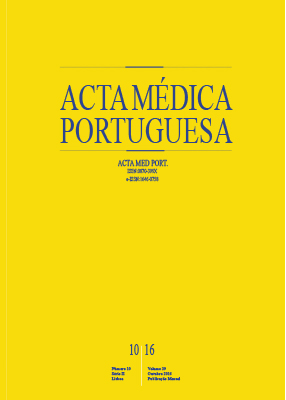Pneumocystis Pneumonia in 107 HIV Infected Patients Admitted to the Department of Infectious Diseases at Santa Maria Hospital, Lisbon (2002 - 2013)
DOI:
https://doi.org/10.20344/amp.7022Keywords:
HIV Infections, Pneumocystis jirovecii, Pneumonia, Pneumocystis, Portugal.Abstract
Introduction: Pneumocystis jirovecii pneumonia remains one of the most common opportunistic illnesses in patients infected with the human immunodeficiency virus. It is currently the most reported AIDS-defining infection in Portugal. The aims of this study were to analyze the features of a human immunodeficiency virus /Pneumocystis jirovecii pneumonia coinfected population, to compare it with the current literature, and to evaluate comparatively subpopulations of patients based on the previous knowledge of the human immunodeficiency virus infection, Pneumocystis jirovecii pneumonia diagnostic method and discharge results.
Material and Methods: A retrospective, observational, non-controlled study was conducted. The 107 patients admitted to the Department of Infectious Diseases at Santa Maria Hospital, in Lisbon, between the 1st of January 2002 and the 31st of December 2013, that presented the simultaneous diagnosis of human immunodeficiency virus infection and Pneumocystis jirovecii pneumonia were included. We studied epidemiologic and clinical data collected from the patient files, including immunity status, human immunodeficiency virus viral load and treatment options. The variables were analyzed using the Chi-Squared and Mann-Whitney tests.
Results: Data from this population evidenced male predominance (81.3%), patient age between 20 - 39 years old in 59.2% and heterossexual human immunodeficiency virus transmission in 48.6%; 24.3% were immigrants. Human immunodeficiency virus infection was previously known in 62.6% patients, but 76.2% were not engaged in medical care. A TCD4+ cell count ≤ 200 cells/mm3, high viral
load and oropharyngeal candidiasis (72%) were prevalent risk factors associated with the Pneumocystis jirovecii pneumonia infection; hypoxaemia (78.5%) and LDH (82.2%), which are markers of Pneumocystis jirovecii pneumonia severity, did not translate into a worse
prognosis. Pneumocystis jirovecii was only identified in 55.1% patients, pointing out the hardship involved in achieving a definite diagnosis. The inicial drug of choice was TMP-SMX (91.6%), and corticosteroid adjuvant therapy was added in 75.7%. The in-hospital mortality was 13.1%.
Discussion: The comparative analysis between groups of patients showed that injection drug users knew more frequently their human immunodeficiency virus seropositivity before the current hospitalization, which could be explained by the presence of specific programs aiming the early human immunodeficiency virus diagnosis in this population. However, there is lack of adhesion to the treatment and
follow up consultations, putting them at a higher risk of Pneumocystis jirovecii pneumonia infection and other AIDS related diseases. Besides showing the classic Pneumocystis jirovecii pneumonia presentation, healthcare seeking was delayed, especially amongst patients with newly diagnosed human immunodeficiency virus infection. Moreover, the Pneumocystis jirovecii pneumonia diagnosis was difficult to obtain, mainly because of the current limitations of Pneumocystis jirovecii pneumonia diagnostic techniques, the simultaneous presence of other respiratory diseases, and the need of a high degree of clinical suspicion.
Conclusion: This population of human immunodeficiency virus and Pneumocystis jirovecii pneumonia coinfected patients shows similarities with the data from previous studies, particularly considering Portuguese epidemiological data. The main differences found were the Pneumocystis jirovecii pneumonia diagnostic frequence in injection drug users, the importance of previous/recurrent episodes of Pneumocystis jirovecii pneumonia as a risk factor and the frequency of concurrent pulmonary diseases. The deceased patients showed less imagiologic features suggestive of Pneumocystis jirovecii pneumonia, and advanced age was found to be an indicative of worst prognosis.
Downloads
Downloads
Published
How to Cite
Issue
Section
License
All the articles published in the AMP are open access and comply with the requirements of funding agencies or academic institutions. The AMP is governed by the terms of the Creative Commons ‘Attribution – Non-Commercial Use - (CC-BY-NC)’ license, regarding the use by third parties.
It is the author’s responsibility to obtain approval for the reproduction of figures, tables, etc. from other publications.
Upon acceptance of an article for publication, the authors will be asked to complete the ICMJE “Copyright Liability and Copyright Sharing Statement “(http://www.actamedicaportuguesa.com/info/AMP-NormasPublicacao.pdf) and the “Declaration of Potential Conflicts of Interest” (http:// www.icmje.org/conflicts-of-interest). An e-mail will be sent to the corresponding author to acknowledge receipt of the manuscript.
After publication, the authors are authorised to make their articles available in repositories of their institutions of origin, as long as they always mention where they were published and according to the Creative Commons license.









